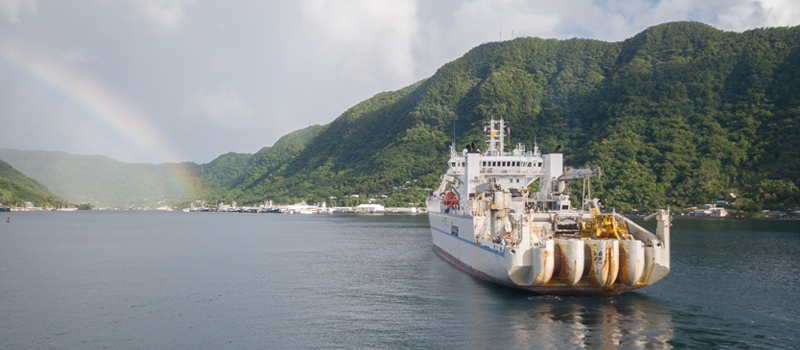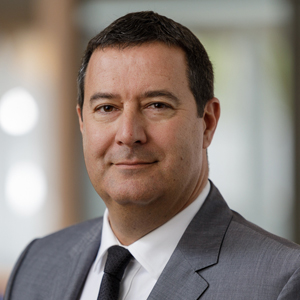

Founder and CEO,
Hawaiki Cable Limited
Hawaiki’s CEO reflects on leadership lessons of building and operating a transoceanic subsea system
When Remi Galasso, CEO of Hawaiki, mulls leadership, he often thinks of his favorite fan sport: rugby. “As a fan of rugby, and considering we are coming out of the Rugby World Cup, I [believe] leading a rugby team or a company requires similar skills,” he says. “The CEO must be, at the same time, the coach and the captain. The coach [is needed] to build the best possible team and define the right strategy to win, and the captain is needed to fight on the ground along with your teammates and lead them to victory, which includes helping them to stand up when one of your own is down.”
A Necessary Disruption?
It is an approach, he says, he wants to see adopted in Hawaiki, itself a new and disruptive player on the high-energy playing field of long–haul subsea connectivity in the Pacific. As a 20–year veteran of the international telecom sector, much of it spent in the region growing and developing businesses, he has no doubts that this disruption was both necessary and inevitable. But it’s also a disruption that has opened new questions on how things are actually done.
“The South Pacific marketplace has been locked for the past 20 years due to the omnipresence of Australian and New Zealand incumbent telcos,” he says. “The alternative connectivity proposed by Hawaiki challenged the status quo and has really opened the market for customers in Australia, New Zealand, the U.S., and Pacific islands.” He contends that, since the Hawaiki launch in July 2018, the capacity market has seen significant price reductions and numerous players creating or expanding their businesses in the Oceania region because of more choices and better economics as a result of the new Hawaiki cable system.
He acknowledges that the region remains a niche market – at least compared to the major Northern Hemisphere systems supplying major economies – but “the same dynamics operate here as everywhere else in the world.” He continues: “From an infrastructure point of view, the continuous deployment of FTTH (such as NBN and UFB in places such as Australia and New Zealand) and 4G/5G mobile networks act as a facilitator.”
The New World of the OTTs
In terms of usage, video content, gaming, and cloud applications are the main drivers of traffic growth, and the regional marketplace is seeing international bandwidth growing by 40 percent per year. In structural terms, he says, the nature of the demand has also forced some rethinking of what the market actually is. “The international capacity market is very much led by the U.S.-based OTTs such as Google, Amazon, Facebook, Apple, Microsoft, and others,” he says. “Their services already represent the majority of traffic and are on track to reach 80 percent in the coming years.”
He argues, in turn, that this OTT domination has “directly impacted the traditional business models of telcos, that are facing a triple challenge: satisfy OTTs’ price requirements, generate revenues to distribute dividends to their shareholders, and invest in their core/domestic business, especially 5G and/or content rights, to retain their subscribers.” He admits that while private cable systems are not immune to these secular trends, and share some of the challenges, “private cables such as Hawaiki operate on a carrier-neutral basis, and are better positioned to serve new generation customers, such as OTTs, thanks to their agility and versatility.”
“We position ourselves as an enabler,” Mr. Galasso says. “Our role is to help our customers grow by thinking out-of-the-box, creating new business models, addressing customers directly, and bringing innovative solutions to the market.” This was the rationale for Hawaiki, he recalls. “This is why we built the Hawaiki Transpacific Cable.” The positioning has proved attractive. OTTs such as AWS, “immediately recognized” the value proposition for US-ANZ connectivity requirements.
All this comes with a certain awareness that change is continuing, and market positioning will remain crucial. The OTT market will itself inevitably evolve, especially in the Asia-Pacific region, he says. “It is likely that the global leadership of U.S. OTTs will be challenged by emerging Chinese players such as Alibaba Group, Tencent, Baidu, Xiaomi, and others, making cable assets even more strategic.”
Meanwhile, in terms of pricing, he contends that regional behaviors will follow global ones as strong growth in demand continues in parallel with falling prices for capacity. “Our region has witnessed this for the past 15 years or so, with an acceleration during the past five years related to the development of new cables on the Australia-U.S. and Australia-Asia routes, including Hawaiki,” he points out. “It is a bit like your broadband connection at home: you get more capacity every year, but you continue to pay around the same price.” Along the way, a connection to American Samoa has sparked a tenfold growth in traffic demand and enabled the creation in August of the Pacific’s first HoloCampus, a 3D hologram e-learning platform linking Hawaii and American Samoa.
New Business Models
But he explains, in the bigger picture, we need to have new insights on the business models involved, and in particular the value chain and the seemingly ever-present potential for commoditization. He remains critical of some established practices. “International bandwidth is still being marketed in ways that are quite old fashioned: carriers sell to large wholesalers, who sell to medium/small wholesalers, who sell to retailers, who sell to enterprises and subscribers,” he points out.
But the amount of data we use – and the way we consume it – is increasingly questioning this multi-layer business model. “Customers are looking for simplification, flexibility, and competitiveness, and we have to satisfy them. This is why we partnered with PacketFabric earlier this year to allow enterprise customers to buy PoP-to-PoP capacity directly on Hawaiki,” Mr. Galasso explains.
Within the community, Hawaiki has been extremely proactive in terms of upgrades, to some extent surprising the market with a series of continuous and very early expansions. The 15,000km long system delivered a designed 67 Tbps capability to the region and saw a 53 percent capacity upgrade in the first few months of operation supported by Ciena WaveLogic 5 Extreme coherent solutions.
“Capacity upgrades have been the most cost-effective way to respond to fast-growing market demand, but the traditional telco models don’t work anymore,” he says. He translates this directly into customer satisfaction: “Customers are tired of waiting for suppliers to complete their upgrade cycles before they can get the capacity they’ve actually ordered. They want it now. Our approach is to be part of the customer cycle and to deliver what they want, when they want it. In this context, Hawaiki has developed a series of new ‘on demand capacity’ solutions, that are very successful among ANZ customers, such as ISPs with ‘bursting’ requirements.”
In his view, the change and rethinking in business models extends to hiring. “At Hawaiki, we aim to hire people who are not only experienced, possessing specific expertise and in-depth knowledge of international communications, but who are also able to think outside the box. We are competing with traditional telcos, many of which have vast human resources, so we have to be smarter, and really prioritize innovation.”
Away from rugby, a final piece of reflection is the power of teamwork in management behaviors. “I am also a strong believer that five brains are better than one, which is why I do regular brainstorming sessions with my management team,” he says. “Listening to different opinions is important if you really want to make the right decisions.”
In all this, he acknowledges that the human capital involved will need to face highly complex and probably unpredictable futures. He singles out AI and deep learning as examples of innovation waves that will probably have both far reaching consequences and demand enormous capacity resources. They will impact, he foresees, every level of the value chain, including the enterprise, and the impact will be on a global scale. “The pace of change today seems to be accelerating, making any effort to predict the future especially challenging.”
In the face of disruption, Mr. Galasso argues: “What we do know, of course, is that everyone, especially in our industry, needs to be better prepared and better able to adapt to this change. As Charles Darwin said, it is not the strongest or the most intelligent who will survive but those who can best manage change.”




